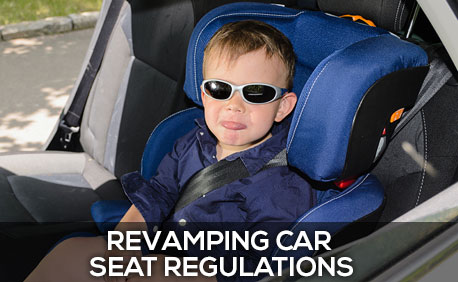There are many things responsible parents do to protect their children, including buckling them in when riding in the car. Statistics from the National Highway Traffic Safety Administration (NHTSA) show that motor vehicle accidents are the leading cause of death for children between one and 13 years of age.
More than a third of children under age 13 who died in passenger vehicle crashes in 2011 were not in car seats or wearing seat belts. You know that these parents’ grief was complicated by regret that they did not insist that their child be safely restrained. Sixty percent of crashes involving children occur ten minutes or less away from home, so they should be buckled up even for short trips.
Children should be kept in car seats or booster seats until they are 12 years old or of sufficient size to wear a regular seat belt. You can find the specific age and size recommendations here: http://www.safercar.gov/parents/RightSeat.htm
In the news this third week of January 2014 is the recommendation of NHTSA that standards be upgraded for car seats designed for children weighing up to 40 pounds. If the proposed regulation is adopted, child car seats would for the first time have to protect children from death and injury in side-impact crashes. New car seats in this category would have to pass a test simulating a T-bone crash where a vehicle going 30 mph strikes a smaller vehicle going 15 mph.
For many years, safety advocates have sought tougher standards for children’s car seats to protect against side-impact crashes. The current regulations for child restraint systems are found in Section 571.213 of the Code of Federal Regulations (http://www.fmcsa.dot.gov/rules-regulations/administration/fmcsr/fmcsrruletext.aspx?reg=571.213). The new regulation proposed by NHTSA won’t take effect immediately. The public will have 90 days to comment on the proposed regulations, then the agency will review the comments and address issues which might be raised; after that, car sear manufacturers will have three years to meet the new requirements.
In the meantime, parents must simply do their best to provide their children with car seats and booster seats that meet current guidelines and must be vigilant about their use. The American Academy of Pediatrics publishes a listing of car seats which meet federal safety standards as of 2013. It is here: http://www.healthychildren.org/English/safety-prevention/on-the-go/Pages/Car-Safety-Seats-Product-Listing.aspx
Additionally, here are some tips that could help you determine if you are using the best protection while transporting your children:
- Never use a car seat that is too old. That bargain you picked up at a yard sale may be outdated and have outlived the manufacturer’s recommended usage.
- Discard a child restraint device if it has any visible cracks in it.
- You need to read the instructions so you can install and use the seat properly. A used device probably won’t come with instructions.
- Do not use a car seat that was recalled. Recalls for the last ten years can be found here: http://www-odi.nhtsa.dot.gov/recalls/childseat.cfm
The federal regulations setting standards for car seats are aimed at manufacturers. However, state laws are aimed at drivers, and a violation of South Carolina’s Child Passenger Safety Seat Law can land you with a $150 fine. This state law is found in Section 56-5-6410. It requires “an appropriate child passenger restraint system” for children 5 years of age or younger. The law gives specifics according to age and weight and states whether the seat must be backward or forward facing. The South Carolina law can be found here: http://www.scdhec.gov/administration/library/CR-008006.pdf
As South Carolina’s law states, “Child safety seats are the most effective occupant protection devices used in motor vehicles today. If used correctly, they are 71 percent effective in reducing fatalities in children under the age of 5 and 69 percent effective in reducing the need for hospitalization.”
Some of us remember the days when kids piled into the family station wagon and were concerned only with complaining that a sibling was unfairly taking up too much of the seat. But the “good old days” weren’t good in all ways, and we need to take advantage of the modern safety requirements imposed on manufacturers of car seats and other consumer goods.
 South Carolina Lawyer Blog
South Carolina Lawyer Blog


